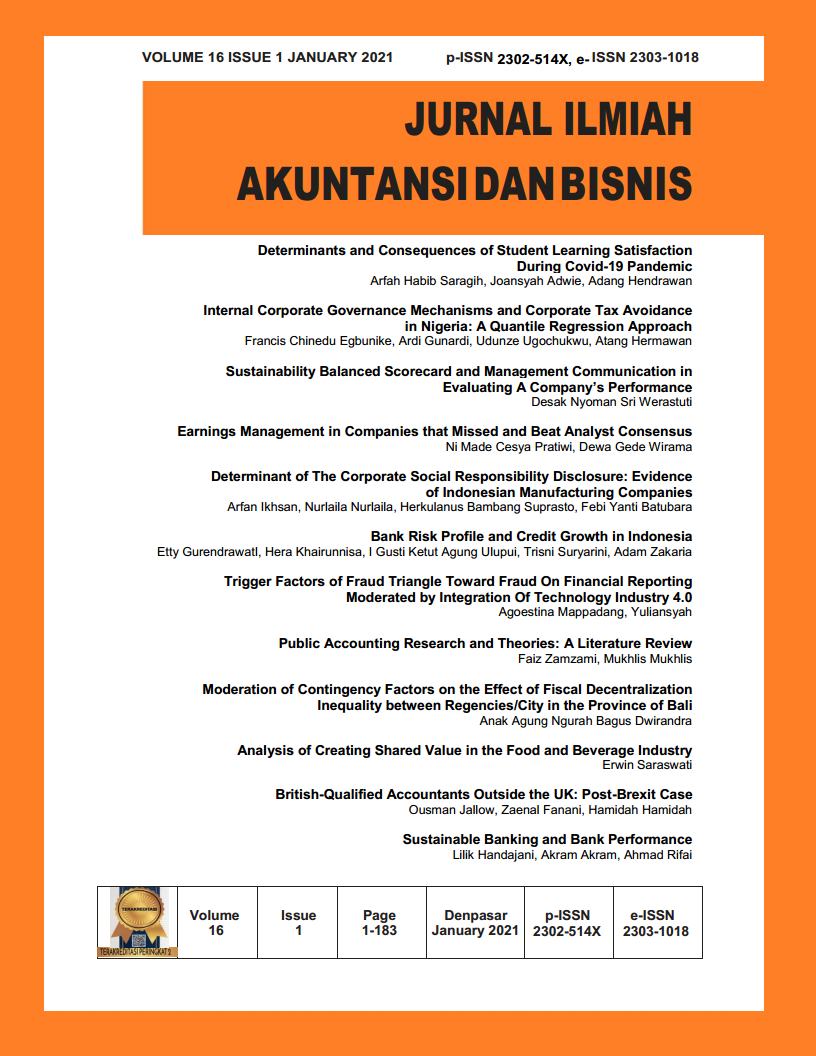Determinants and Consequences of Student Learning Satisfaction During Covid-19 Pandemic
Abstract
This study examines the effect of student perception in online learning on student satisfaction and its impact on student learning performance and intention to use in the future. The regression analysis method was used based on the survey results from 157 students. Results indicate that students' perceptions of online learning had a positive effect on student satisfaction, intention to use, and student learning performance. Further, student satisfaction has a positive effect on student learning performance but does not affect the intention to use. The implications for lecturers, students, and faculties are also discussed.
Keywords: student perception, online learning, student satisfaction, student performance, intention to use, covid-19 pandemic
Downloads
References
Benta, D., Bologa, G., & Dzitac, I. (2014). E-learning platforms in higher education. Case study. Procedia Computer Science, 31, 1170–1176. https://doi.org/10.1016/j.procs.2014.05.373
Bertea, P. (2005). Measuring Students ’ Attitude Towards E-Learning . a Case Study. The 5th International Scientific Conference ELearning and Software for Education, 8. http://citeseerx.ist.psu.edu/viewdoc/download?doi=10.1.1.623.6294&rep=rep1&type=pdf
Chang, Y.-J., Chen, C.-H., Huang, W.-T., & Huang, W.-S. (2011). Investigating students’ perceived satisfaction, behavioral intention, and effectiveness of English learning using augmented reality. 2011 IEEE International Conference on Multimedia and Expo, 1–6. https://doi.org/10.1109/ICME.2011.6012177
Chitkushev, L., Vodenska, I., & Zlateva, T. (2014). Digital Learning Impact Factors: Student Satisfaction and Performance in Online Courses. International Journal of Information and Education Technology, 4(4), 356–359. https://doi.org/10.7763/ijiet.2014.v4.429
Chow, W. S., & Shi, S. (2014). Investigating Students’ Satisfaction and Continuance Intention toward E-learning: An Extension of the Expectation – Confirmation Model. Procedia - Social and Behavioral Sciences, 141, 1145–1149. https://doi.org/10.1016/j.sbspro.2014.05.193
Davis, F D. (1985). A technology acceptance model for empirically testing new end-user information systems: Theory and results. Management, Ph.D.(May), 291. https://doi.org/oclc/56932490
Davis, Fred D. (1989). Perceived usefulness, perceived ease of use, and user acceptance of information technology. MIS Quarterly: Management Information Systems, 13(3), 319–339. https://doi.org/10.2307/249008
Eichelberger, A., & Ngo, H. T. P. (2018). College Students’ Perception of an Online Course in Special Education. International Journal for Educational Media and Technology, 12(2), 11–19. https://www.researchgate.net/publication/335777401
Fadare, O. A., Ibrahim, M. B., & Edogbanya, A. (2016). A survey on perceived risk and intention of adopting internet banking. Journal of Internet Banking and Commerce, 21(1), 1–21.
Fornell, C., & Larcker, D. F. (1981). Evaluating Structural Equation Models with Unobservable Variables and Measurement Error. Journal of Marketing Research, 18(1), 39. https://doi.org/10.2307/3151312
Hair, Joe F., Sarstedt, M., Ringle, C. M., & Mena, J. A. (2012). An assessment of the use of partial least squares structural equation modeling in marketing research. Journal of the Academy of Marketing Science, 40(3), 414–433. https://doi.org/10.1007/s11747-011-0261-6
Hair, Joseph F., Risher, J. J., Sarstedt, M., & Ringle, C. M. (2019). When to use and how to report the results of PLS-SEM. European Business Review, 31(1), 2–24. https://doi.org/10.1108/EBR-11-2018-0203
Ke, F., & Kwak, D. (2013). Online learning across ethnicity and age: A study on learning interaction participation, perception, and learning satisfaction. Computers & Education, 61, 43–51. https://doi.org/https://doi.org/10.1016/j.compedu.2012.09.003
Keengwe, J., & Georgina, D. (2012). The digital course training workshop for online learning and teaching. Education and Information Technologies, 17(4), 365–379. https://doi.org/10.1007/s10639-011-9164-x
Kock, N. (2014). Advanced Mediating Effects Tests, Multi-Group Analyses, and Measurement Model Assessments in PLS-Based SEM. International Journal of E-Collaboration, 10(1), 1–13. https://doi.org/10.4018/ijec.2014010101
Lee, J.-W., & Mendlinger, S. (2011). Perceived Self-Efficacy and Its Effect on Online Learning Acceptance and Student Satisfaction. Journal of Service Science and Management, 04(03), 243–252. https://doi.org/10.4236/jssm.2011.43029
Lee, J. W. (2010). Online support service quality, online learning acceptance, and student satisfaction. Internet and Higher Education, 13(4), 277–283. https://doi.org/10.1016/j.iheduc.2010.08.002
Liaw, S.-S., & Huang, H.-M. (2013). Perceived satisfaction, perceived usefulness and interactive learning environments as predictors to self-regulation in e-learning environments. Computers & Education, 60(1), 14–24. https://doi.org/https://doi.org/10.1016/j.compedu.2012.07.015
Liaw, S.-S., Huang, H.-M., & Chen, G.-D. (2007). Surveying instructor and learner attitudes toward e-learning. Computers & Education, 49(4), 1066–1080. https://doi.org/https://doi.org/10.1016/j.compedu.2006.01.001
Lust, G., Elen, J., & Clarebout, G. (2012). Online Measurement Perspectives for Students’ Strategy Use: Tool Use within a Content Management System. Education Research International, 2012, 1–11. https://doi.org/10.1155/2012/702315
Paechter, M., Maier, B., & Macher, D. (2010). Students’ expectations of, and experiences in e-learning: Their relation to learning achievements and course satisfaction. Computers & Education, 54(1), 222–229. https://doi.org/https://doi.org/10.1016/j.compedu.2009.08.005
Schuberth, F., Henseler, J., & Dijkstra, T. K. (2018). Partial least squares path modeling using ordinal categorical indicators. Quality and Quantity, 52(1), 9–35. https://doi.org/10.1007/s11135-016-0401-7
Tseng, H. (2020). An exploratory study of students’ perceptions of learning management system utilisation and learning community. Research in Learning Technology, 28(1063519), 1–18. https://doi.org/10.25304/rlt.v28.2423
Wei, H. C., & Chou, C. (2020). Online learning performance and satisfaction: do perceptions and readiness matter? Distance Education, 41(1), 48–69. https://doi.org/10.1080/01587919.2020.1724768
Yang, Y., & Lin, N. C. (2010). Internet perceptions, online participation and language learning in Moodle forums: A case study on nursing students in Taiwan. Procedia - Social and Behavioral Sciences, 2(2), 2647–2651. https://doi.org/10.1016/j.sbspro.2010.03.388




















